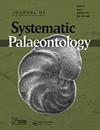Phylogenetic analysis of Ceratophryidae (Anura: Hyloidea) including extant and extinct species
IF 2.2
2区 地球科学
Q3 EVOLUTIONARY BIOLOGY
引用次数: 1
Abstract
The Neotropical frog family Ceratophryidae is composed of wide-mouthed frogs with stout bodies. Living species of the family are consistently recovered as a monophyletic group, but with disparities among analyses regarding internal relationships. Ceratophryidae presents one of the richest fossil records in Anura. Nevertheless, phylogenetic analyses including both extant and extinct species are still scarce, and the position of fossils is persistently debated. In this sense, the systematics of the family has changed considerably in the last decade with the exclusion of Baurubatrachus pricei (Late Cretaceous), Beelzebufo ampinga (Late Cretaceous) and Wawelia gerholdi (early Miocene). Herein, a morphologically based phylogeny for Ceratophryidae, including living species (11 spp.) and fossil specimens (10 spp.), is used as a background to discuss the evolutionary history of the family and its classification. We phylogenetically placed Baurubatrachus pricei, Beelzebufo ampinga and Wawelia gerholdi as non-ceratophryids. We recovered a monophyletic Ceratophryidae: Lepidobatrachus and Ceratophrys form a clade, with Chacophrys as its sister group. Our analysis corroborates the C. cornuta and C. aurita groups. Among fossils, L. australis and C. sagani were recovered as valid species based on autapomorphies, and C. rusconii was found to be the sister of all Ceratophrys. Ceratophrys ensenadensis, C. ameghinorum, C. aurita NHMUK PV OR18895/6 and C. sagani belong to the C. aurita group. We also discuss homoplasies in Ceratophryidae, divergence-time estimates, and the evolution of ploidy and a dorsal shield in the family.包括现存和已灭绝物种在内的金花藻科(Anura:Hyloidea)的系统发育分析
新热带蛙科角蛙科由身体粗壮的宽口蛙组成。该科的现存物种一直被恢复为单系群,但在关于内部关系的分析中存在差异。角鼻兽科是无尾动物化石记录最丰富的物种之一。然而,包括现存和灭绝物种的系统发育分析仍然很少,化石的位置也一直存在争议。从这个意义上说,随着Baurubatrachus pricei(晚白垩世)、Beelzebufo ampinga(晚白垩世)和Wawelia gerholdi(早中新世)的排除,该科的分类学在过去十年发生了很大的变化。本文以形态学为基础的角鼻蝇科系统发育,包括现存物种(11种)和化石标本(10种),作为讨论该科进化历史及其分类的背景。在系统发育上,我们将Baurubatrachus pricei、Beelzebufo ampinga和Wawelia gerholdi列为非蠓类。我们恢复了一个单系的角鼻蝇科:鳞翅目和角鼻蝇形成一个分支,其姊妹类群为角鼻蝇。我们的分析证实了C. cornuta和C. aurita类群。在化石中,根据自形性发现了L. australis和C. sagani,发现C. rusconii是所有角鼻类的姐妹种。Ceratophrys ensenadensis、C. ameghinorum、C. aurita NHMUK PV OR18895/6和C. sagani属于aurita类群。我们还讨论了角鼻虫科的同源性,分化时间估计,以及家族中倍性和背盾的进化。
本文章由计算机程序翻译,如有差异,请以英文原文为准。
求助全文
约1分钟内获得全文
求助全文
来源期刊
CiteScore
5.30
自引率
7.70%
发文量
31
审稿时长
>12 weeks
期刊介绍:
The Journal of Systematic Palaeontology publishes papers that provide novel and impactful results in phylogenetics and systematics and that use these results in ways that significantly advance rigorous analyses of palaeogeography, palaeobiology, functional morphology, palaeoecology or biostratigraphy. Papers dealing with theoretical issues or molecular phylogenetics are also considered if they are of relevance to palaeo-systematists. Contributions that include substantial anatomical descriptions, descriptions of new taxa or taxonomic revisions are welcome, but must also include a substantial systematics component, such as a new phylogeny or a revised higher-level classification. Papers dealing primarily with alpha-taxonomic descriptions, the presentation of new faunal/floristic records or minor revisions to species- or genus-level classifications do not fall within the remit of the journal.

 求助内容:
求助内容: 应助结果提醒方式:
应助结果提醒方式:


